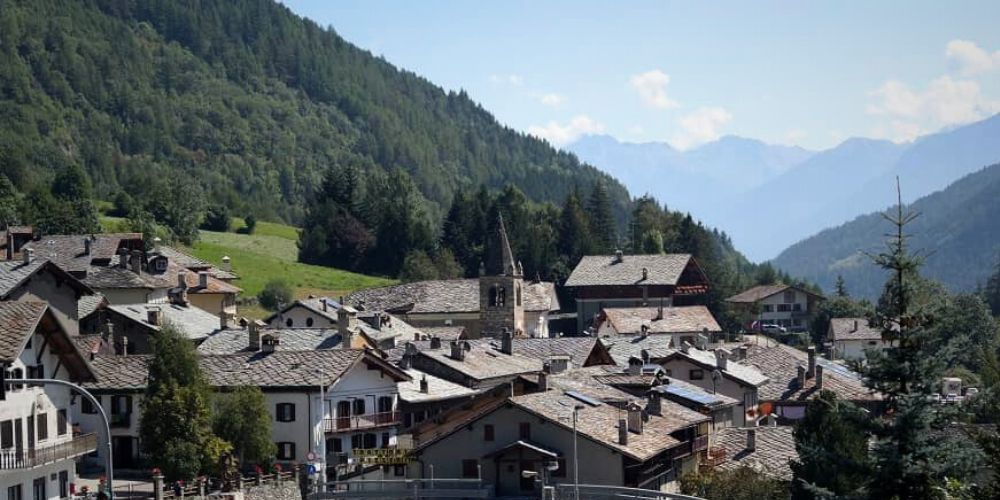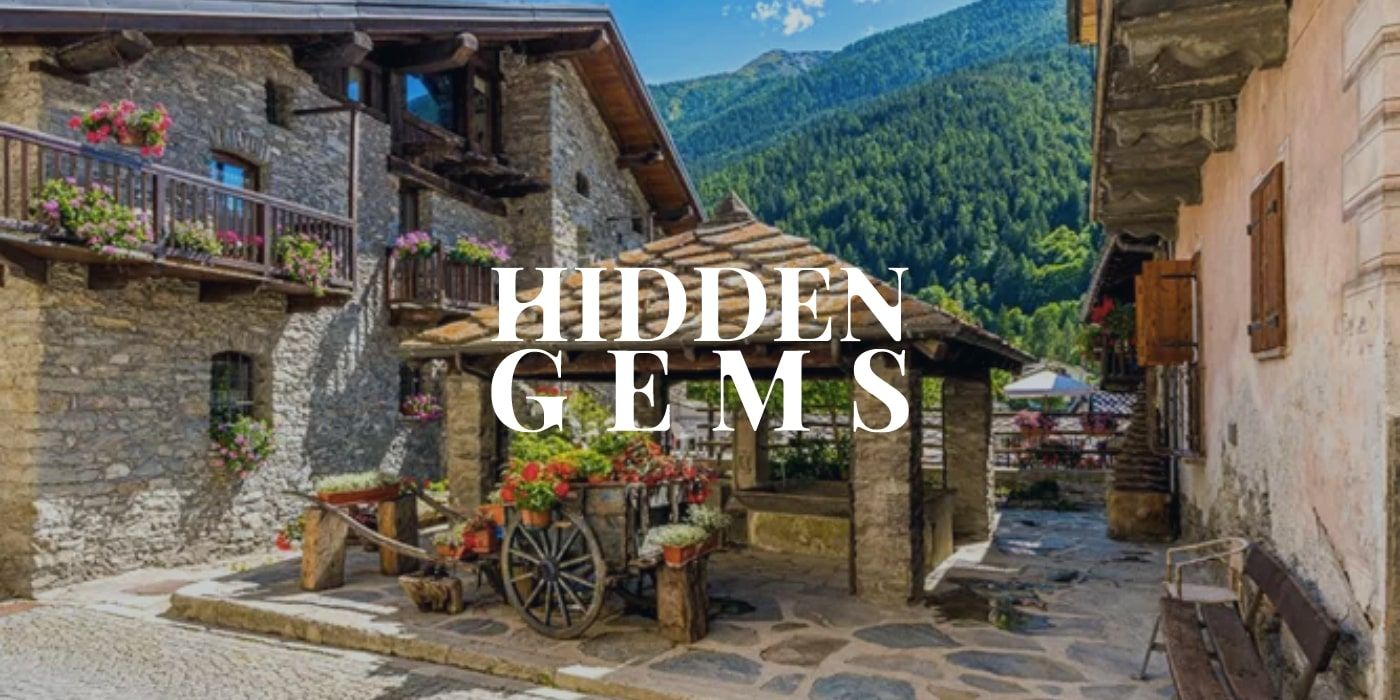Étroubles is a tiny village set like a beautiful gem on the Alpine peaks. Situated at an altitude of almost 3000 m, it stands in the heart of the Great St Bernard Valley, about 20 km from Aosta. Étroubles witnesses an ancient past and hosts enchanting places to admire among artistic and natural beauties.
In particular, Étroubles is the home to a permanent art gallery that makes the burg a stunning open-air museum capable of impressing visitors at first sight. Moreover, if it’s not enough, Étroubles is surrounded by breathtaking natural landscapes that surely shall make the happiness of winter sports and hiking lovers.
These characteristics make this charming village in Aosta Valley one of the most beautiful hidden gems in Italy. Discover with us what to ses and what to do in Étroubles!

What to see in Étroubles: a fabled walk in this village in Aosta Valley

The name of the village of Étroubles probably comes from a term in the patois of Aosta Valley (a Franco-Provençal dialect) used to indicate a place rich in fields covered in straw. In fact, until the 1960s, vast fields of wheat and rye abounded around the village.
However, the beauty of Étroubles lies essentially in its fairytale old town, framed by the charming mountain landscape. Wooden and stone buildings and cobbled streets dominate the urban structure of the old town of Étroubles, where among typical shops and pretty houses with flowery balconies you will experience an immersion in a cosy and dream-like atmosphere.
Étroubles hosts a remarkable religious architecture. In particular, the Church of Santa Maria Assunta was rebuilt at the beginning of the 19th century on a pre-existing church dating back to the 12th century, whereas the so-called Five Chapels witness the devotion and faith of the inhabitants of the main villages in the valley: Echevennoz is the oldest one, founded in the 15th century and characterized by spectacular wall paintings.
The fascinating permanent art gallery through the streets of Étroubles

“À Étroubles, avant toi sont passés…” is the title chosen for the permanent art gallery organised in collaboration with the Fondation Gianadda of Martigny in the old town of Étroubles. It’s a real artistic path to follow among sculptures, installations and contemporary paintings created by internationally renowned artists that sprinkle the Étroubles's streets giving it a great sense of vitality and making it a breathtaking open-air museum to explore.
What to do in Étroubles: history, sport, nature and folklore

The Romans already knew the location of the enchanting village of Étroubles as a strategic point in the valley. They called it Restopolis, a transit route to Alpis Poenina, today's Great St Bernard Pass. Later, the same path became the Via Francigena, the most crucial road linking Rome and Jerusalem with the British Isles. Even today many pilgrims still travel along this path.
Not only art and rural life: Étroubles is the perfect destination if you are passionate about winter sports and outdoor activities. As for the former, we recommend the well-equipped Great St Bernard ski area, where you can enjoy downhill skiing, Nordic skiing, mountaineering and snowboarding. If you want to learn more about winter sports in Aosta Valley, click here.
On the other hand, if you love nature and long walks in the countryside we recommend a visit to the valleys surrounding the village: during the summer months, the mild temperatures make it possible to tackle trekking routes, excursions, long crossings in uncontaminated valleys, especially in barefooting, as well as the abovementioned Via Francigena route. Do you enjoy riding a bike? Then you might be interested in exploring the cycle paths in Aosta Valley along the Dora Baltea river, find out more here.
Among Étroubles’s most famous, curious and characteristic festivals the Carnival of the Coumba Freida (meaning Cold Valley) stands out. Every year it commemorates the passage of Napoleon's troops to the Gran San Bernardo pass, a terrible event that terrified the local population. Over the years, a tradition has developed of creating a picturesque parody of the event to exorcise the fear: the so-called landzette, disturbing masks wearing costumes that recall the colours of Napoleon's military uniforms, parade through the village on these festive days.
In summer, Étroubles revives old trades thanks to La Veillà: this event is an opportunity to rediscover the village's ancient cultural roots, such as threshing wheat and making fontina cheese, the local staple. People celebrate the occasion by serving wine, good food and playing live music.
The typical products of Étroubles

Along the road towards the adjacent Vachéry hamlet, you will come across the first dairy of the region, dating back to the mid-19th century. Today, it has been transformed into a museum where you can observe all the various stages of cheese making using the tools of the time. In Eternod, another adjacent hamlet of Étroubles, you can see the last of the old ovens used in the past for black baking bread. As we shall see, it is a typical preparation of this area of Valle d'Aosta. In short, a real plunge into the past!
You cannot leave Étroubles without trying its flagship product: the PDO alpine fontina cheese. This typical local cheese is one of the traditional highlights along with black bread. The milk used to produce it comes exclusively from cows born and bred in Valle d'Aosta. Rye and wheat bread, on the other hand, come from the ancient customs of farming families, as it was the basis of their diet. Even today, people preserve the tradition of baking it in a community wood-fired oven once a year. Not surprisingly, one of the tastiest dishes is a soup with fontina cheese and black bread. However, there is no shortage of meat and fish dishes, such as the famous trota alla valdostana (trout), a recipe rich in scents and intense flavours.
Are you looking for a souvenir to bring back home after your trip to Aosta Valley? Take a look at the magnificent wood handicraft that you can find in Étroubles, click here.
What to visit near Étroubles: discover Aosta Valley

Étroubles allows you to visit another centre of great historical and cultural interest in its immediate surroundings: Aosta, located in the region's heart halfway between the Swiss and French borders. Did you know this city hosts the largest number of Roman remains after Rome itself?
If you want to visit Étroubles and the wonderful Aosta Valley during the magical Christmas time, here's some key information for you about the most beautiful Christmas markets in the region. Do you want to enjoy warm baths, wellness and specific treatments for your body? Find out here about the best thermal baths where to give yourself moments of pure relaxation.
About the author
Written on 02/08/2023



Sabrina Fabozzi
Come with us to Étroubles, a village nestled in the landscape of Aosta Valley rich in history, traditions and artistic and natural beauties.